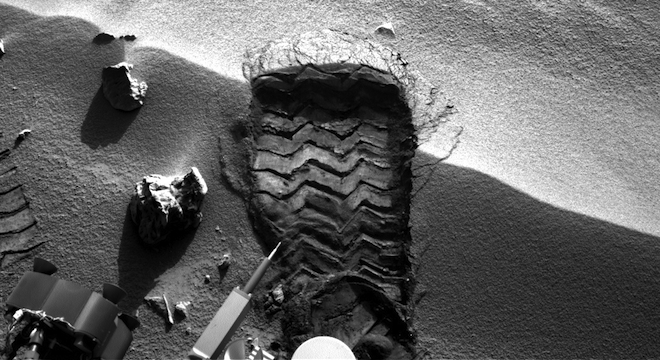NASA’s Mars Curiosity Rover is preparing to clean itself, but first, it has to get dirty. The rover is set to begin scooping up spoonful-sized samples of Martian sand on Sunday and shake them through its instruments in order to scrub the $2.5 billion car-sized mobile laboratory clean, NASA scientists announced on Thursday in a press conference.
“We use sand and fine material at Mars to finish cleaning out our hardware,” said Daniel Limonadi, head of the rover’s surface sampling operations, in the press conference.
That’s because despite the fact that NASA takes painstaking steps to ensure its interplanetary probes are free of contamination before launch (a process that suffered a minor lapse in Curiosity’s case), even the cleanest space-bound instruments contain an oily film from just being on Earth in the first place.
“Even though we make this hardware is super squeaky clean, by virtue of just being on Earth, you get residual oily film thats impossible to get rid of,” Limonadi explained. “You really have to scrub away mono layer of oils. To do that, we take fine grain material and effectively use it to rinse our mouth.”
NASA’s not just looking to use Martian sand as a cleaning implement: The agency also wants to study it, of course, and understand obtain data about its characteristics, including chemical and mineralogical composition.
But in order to do that, the rover first needs to get those very instruments capable of analyzing sand samples scrubbed.
The actual scooping instrument on the Rover is called CHIMRA, the Collection and Handling for In-Situ Martian Rock Analysis. Here’s a NASA illustration pointing out where it’s located on the end of the rover’s 7-foot-long robotic arm relative to the other five instruments on the rover’s “hand”:

The CHIMRA tool contains a tiny scoop 4-centimeters wide and 7-centimeters long, as well as a smaller 150-micrometer sieve for sifting the sand and a portion box for storing it while it gets analyzed by the other four instruments on the rover’s hand.
Here’s a NASA illustration showing the components of the CHIMRA instrument:

But for cleaning purposes, the most important part of the CHIMRA is a large cylindrical vibration mechanism (indicated in the NASA illustration above), which actually shakes the sand through the entirety of the rover’s hand at a force of 8Gs, operating at a frequency between 70-85 hertz.
“It looks and feels like if you opened the hood of your car and looked at the engine running,” Limonadi said. “It makes this ‘badadada’ engine running sound.”
The initial scooping and cleaning operation — which involves four separate scoops of sand, the last of which actually gets thoroughly analyzed for its composition by other instruments on the end of the rover’s arm — is expected to take between two and three weeks, especially as the scientists take their time to ensure everything is working correctly on CHIMRA, according to Limonadi.
That’s why NASA spent the past several Martian days testing the sand at the rover’s current location, an area dubbed “Rocknest,” to ensure that it was fine enough and mundane enough to be able to clean the rover without damaging the sensitive instruments or posing any other complications.
Specifically, NASA moved the rover’s wheel around 90-degrees in the sand to disturb it, as shown in the following image captured by one of the rover’s black-and-white Navigational camera pair (Navcam):

“We’re looking for boring safe typical Martian sand that you find in dunes,” said NASA Curiosity mission manager Michael Watkins during the press conference. “Because we’ll have this sample inside our hardware for days or weeks, we want to make sure it wont do anything weird, like absorb water or turn into paste.”
Watkins called Rocknest “a good sandpit to play in.”
Rocknest, the rover’s current site, is over a quarter mile away (1,300 feet or 400 meters) from where it first landed on the Red Planet on August 6, but still within the 96-mile-wide ancient impact site known as Gale Crater where the entirety of the two-year long science mission is expected to take place.
The rover has driven a total of 1587 feet (484 meters) since it touched down but still has another 577 feet (176 meters) to go before it reaches its first science target, an area of what looks to be diverse Martian geology that NASA has named “Glenelg.”
NASA released the following map Thursday charting the rover’s progress across the Red Planet’s alien landscape so far (white dotted line) and its upcoming path (green):

At Glenelg, Curiosity’s scientist operators plan to use the drill located on the rover’s arm, which they hope will find more answers to their questions about an ancient, long dried up body of liquid water that appears to flowed down through nearby channels, forming gravely zones that look similar to streambeds here on Earth.
Ultimately, before the 23-month science mission is up, NASA expects to drive the nuclear powered rover over to a 3.4-mile-high Martian mountain named Mount Sharp, also located within Gale Crater.






